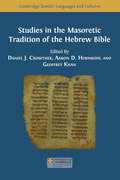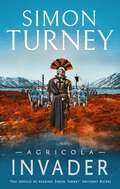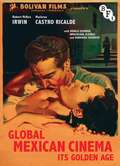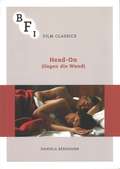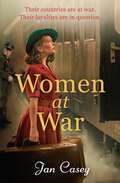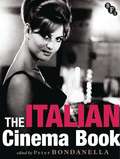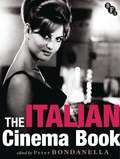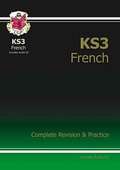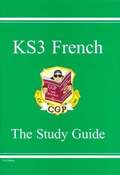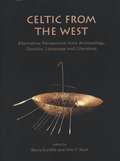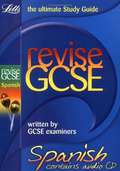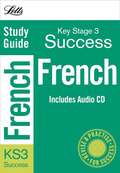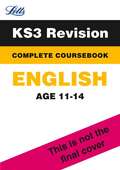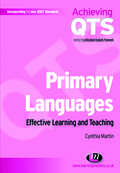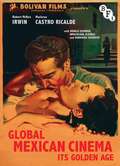- Table View
- List View
Ancient Greek I: A 21st Century Approach
by Philip S. PeekIn this elementary textbook, Philip S. Peek draws on his twenty-five years of teaching experience to present the ancient Greek language in an imaginative and accessible way that promotes creativity, deep learning, and diversity. The course is built on three pillars: memory, analysis, and logic. Readers memorize the top 250 most frequently occurring ancient Greek words, the essential word endings, the eight parts of speech, and the grammatical concepts they will most frequently encounter when reading authentic ancient texts. Analysis and logic exercises enable the translation and parsing of genuine ancient Greek sentences, with compelling reading selections in English and in Greek offering starting points for contemplation, debate, and reflection. A series of embedded Learning Tips help teachers and students to think in practical and imaginative ways about how they learn. This combination of memory-based learning and concept- and skill-based learning gradually builds the confidence of the reader, teaching them how to learn by guiding them from a familiarity with the basics to proficiency in reading this beautiful language. Ancient Greek I: A 21st-Century Approach is written for high-school and university students, but is an instructive and rewarding text for anyone who wishes to learn ancient Greek.
Studies in the Masoretic Tradition of the Hebrew Bible: (pdf)
by Daniel J. Crowther Aaron D. Hornkohl Geoffrey KhanThis volume brings together papers on topics relating to the transmission of the Hebrew Bible from Late Antiquity to the Early Modern period. We refer to this broadly in the title of the volume as the ‘Masoretic Tradition’. The papers are innovative studies of a range of aspects of this Masoretic tradition at various periods, many of them presenting hitherto unstudied primary sources. They focus on traditions of vocalisation signs and accent signs, traditions of oral reading, traditions of Masoretic notes, as well as Rabbinic and exegetical texts. The contributors include established scholars of the field and early-career researchers.
(u)Mzantsi Classics: Dialogues in Decolonisation from Southern Africa
An Open Access edition of this book will be available on publication on the Liverpool University Press and African Minds websitesThough Greco-Roman antiquity (‘classics’) has often been considered the handmaid of colonialism, its various forms have nonetheless endured through many of the continent’s decolonising transitions. Southern Africa is no exception. This book canvasses the variety of forms classics has taken in Zimbabwe, Mozambique and especially South Africa, and even the dynamics of transformation itself. How does (u)Mzantsi classics (of southern Africa) look in an era of profound change, whether violent or otherwise? What are its future prospects? Contributors focus on pedagogies, historical consciousness, the creative arts and popular culture. The volume, in its overall shape, responds to the idea of dialogue – in both the Greek form associated with Plato’s rendition of Socrates’ wisdom and in the African concept of ubuntu. Here are dialogues between scholars, both emerging and established, as well as students – some of whom were directly impacted by the Fallist protests of the late 20-teens. Rather than offering an apologia for classics, these dialogues engage with pressing questions of relevance, identity, change, the canon, and the dynamics of decolonisation and potential recolonisation. The goal is to interrogate classics – the ways it has been taught, studied, perceived, transformed and even lived – from many points of view.
Learning Greek with Plato: A Beginner's Course in Classical Greek (Bristol Phoenix Press Classical Handbooks)
by Frank BeethamAdult learners of ancient Greek are often attracted to it by the prospect of being able to read in the original a particular author or genre. Greek philosophical writing and Plato in particular is often the target. This book’s material has been tried and tested by the author over the years with adult classes, and can be used as a course textbook, or as a handbook for self-teaching.Each of 25 sections is clearly laid out – with tabulation of Greek word-forms and grammar. Each includes ample exercises and practice in reading Greek sentences. Readings in later sections consist of passages of continuous Greek from Plato’s Meno, a typical Platonic dramatic dialogue.
Work and Labour in the Cities of Roman Italy (Liverpool Studies in Ancient History)
by Miriam Groen-VallingaWork and labour are fundamental to an understanding of Roman society. In a world where reliable information was scarce and economic insecurity loomed large, social structures and networks of trust were of paramount importance to the way work was provided and filled in. Taking its cue from New Institutional Economics, this book deals with the wide range of factors shaping work and labour in the cities of Roman Italy under the early empire, from families and familial structures, to labour collectives, slavery, education and apprenticeship. To illuminate the complexity of the market for labour, this monograph offers a new analysis of the occupational inscriptions and reliefs from Roman Italy, placing them in the wider context by means of documentary evidence like apprenticeship contracts, legal sources, and material remains. This synthesis therefore provides a comprehensive analysis of the ancient sources on work and labour in Roman urban society, leading to a novel interpretation of the market for work, and a fuller understanding of the daily lives of nonelite Romans. For some of them, work was indeed a source of pride, whereas for others it was merely a means to an end or a necessity of life.
The Ancient Sea: The Utopian and Catastrophic in Classical Narratives and their Reception
In the ancient Mediterranean world, the sea was an essential domain for trade, cultural exchange, communication, exploration, and colonisation. In tandem with the lived reality of this maritime space, a parallel experience of the sea emerged in narrative representations from ancient Greece and Rome, of the sea as a cultural imaginary. This imaginary seems often to oscillate between two extremes: the utopian and the catastrophic; such representations can be found in narratives from ancient history, philosophy, society, and literature, as well as in their post-classical receptions. Utopia can be found in some imaginary island paradise far away and across the distant sea; the sea can hold an unknown, mysterious, divine wealth below its surface; and the sea itself as a powerful watery body can hold a liberating potential. The utopian quality of the sea and seafaring can become a powerful metaphor for articulating political notions of the ideal state or for expressing an individual’s sense of hope and subjectivity. Yet the catastrophic sea balances any perfective imaginings: the sea threatens coastal inhabitants with floods, tsunamis, and earthquakes and sailors with storms and the accompanying monsters. From symbolic perspectives, the catastrophic sea represents violence, instability, the savage, and even cosmological chaos. The twelve papers in this volume explore the themes of utopia and catastrophe in the liminal environment of the sea, through the lens of history, philosophy, literature and classical reception.Contributors: Manuel Álvarez-Martí-Aguilar, Vilius Bartninkas, Aaron L. Beek, Ross Clare, Gabriele Cornelli, Isaia Crosson, Ryan Denson, Rhiannon Easterbrook, Emilia Mataix Ferrándiz, Georgia L. Irby, Simona Martorana, Guy Middleton, Hamish Williams.
Agricola: Invader (Agricola #1)
by Simon TurneyThe first volume in a thrilling new historical adventure series by Simon Turney, critically acclaimed author of Legion XXII and Sons of Rome.58 AD, Rome. Agricola, teenage son of an impoverished yet distinguished noble family, has staked all his resources and reputation on a military career. His reward? A posting as tribune in the far-off northern province of Britannia. Serving under renowned general Suetonius Paulinus, Agricola soon learns the brutality of life on the very edges of the empire, for the Celtic tribes of Britannia are far from vanquished. To take control of the province, the Romans must defeat the ancient might of the druids - and the fury of the Iceni, warriors in their thousands led by a redoubtable queen named Boudicca...Reviews for Simon Turney'If you want gritty and utterly authentic edge of the seat Roman action, you should be reading Simon Turney.' Anthony Riches'A vivid, historically authentic Roman military thriller.' Alex Gough'Brings a whole new dimension to the genre.' Historical Novel Society'Brimming with tension, mystery and adventure!' Gordon Doherty'First-rate Roman fiction.' Matthew Harffy
Body Technologies in the Greco-Roman World: Technosôma, gender and sex
by Maria Gerolemou and Giulia Maria ChesiA collection of papers that introduces the notion of the technosoma (techno body) into discussions on the representations of the body in classical antiquity. By applying the category of the technosoma to the ‘natural’ body, this volume explicitly narrows down the discussion of the technical and the natural to the physiological body. In doing so, the present collection focuses on body technologies in the specific form of beautification and body enhancement techniques, as well as medical and surgical treatments. The volume elucidates two main points. Firstly, ancient techno bodies show that the categories of gender and sexuality are at the core of the intersection of the natural and the technical, and intersect with notions of race, age, speciesism, class and education, and dis/ability. Secondly, the collection argues that new body technologies have in fact a very ancient history that can help to address the challenges of contemporary technological innovation. To this end, the volume showcases the intersection of ‘natural’ bodies with technology, gender, sexuality and reproduction. On the one hand, techno bodies tend to align with normative ideas about gender, and sexuality. On the other hand, body modification and/or enhancement techniques work hand in hand with economic and political power and knowledge, thus they often produce techno bodies that are shaped according to individual needs, i.e. according to a certain lifestyle. Consequently, techno bodies threaten to alter traditional ideas of masculinity, femininity, male and female sexuality and beauty.
The Arab Writer in English: Arab Themes in a Metropolitan Language, 1908-1958
by Geoffrey NashThis book looks at the first generation of Arab British and Arab-American writers to produce English writings in the earlier twentieth-century: Ameen Rihani, Khalil Jibran, George Antonius and Edward Atiyah. It theorises their work within the context of Arab nationalism, postcolonialism and the criticism of Edward Said.
Body Technologies in the Greco-Roman World: Technosôma, gender and sex
A collection of papers that introduces the notion of the technosoma (techno body) into discussions on the representations of the body in classical antiquity. By applying the category of the technosoma to the ‘natural’ body, this volume explicitly narrows down the discussion of the technical and the natural to the physiological body. In doing so, the present collection focuses on body technologies in the specific form of beautification and body enhancement techniques, as well as medical and surgical treatments. The volume elucidates two main points. Firstly, ancient techno bodies show that the categories of gender and sexuality are at the core of the intersection of the natural and the technical, and intersect with notions of race, age, speciesism, class and education, and dis/ability. Secondly, the collection argues that new body technologies have in fact a very ancient history that can help to address the challenges of contemporary technological innovation. To this end, the volume showcases the intersection of ‘natural’ bodies with technology, gender, sexuality and reproduction. On the one hand, techno bodies tend to align with normative ideas about gender, and sexuality. On the other hand, body modification and/or enhancement techniques work hand in hand with economic and political power and knowledge, thus they often produce techno bodies that are shaped according to individual needs, i.e. according to a certain lifestyle. Consequently, techno bodies threaten to alter traditional ideas of masculinity, femininity, male and female sexuality and beauty.
Global Mexican Cinema: Its Golden Age (Cultural Histories of Cinema)
by Maricruz Ricalde Robert McKee IrwinThe golden age of Mexican cinema, which spanned the 1930s through to the 1950s, saw Mexico's film industry become one ofthe most productive in the world, exercising a decisive influence on national culture and identity. In the first major study of the global reception and impact of Mexican Golden Age cinema, this book captures the key aspects of its international success, from its role in forming a nostalgic cultural landscape for Mexican emigrants working in the United States, to its economic and cultural influence on Latin America, Spain and Yugoslavia. Challenging existing perceptions, the authors reveal how its film industry helped establish Mexico as a long standing centre of cultural influence for the Spanish-speaking world and beyond.
Head-On (BFI Film Classics)
by Daniela BerghahnWhen Head-On (Gegen die Wand, 2004) won the Golden Bear at the Berlin International Film Festival, it was hailed as a turning point for German cinema. Not only was this unconventional love story the first German film in eighteen years to win the prestigious award, but the success of writer-director Fatih Akin was also celebrated as the revival of German auteur cinema. Meanwhile Turkey claimed Akin as its own prodigal son and his film a victory for Turkish cinema.Daniela Berghahn provides a detailed and entertaining account of the film's artistic inspirations, its production history and the debates that surrounded it in the German and Turkish press. Arguing that much of the media discourse on Turkish German identity politics detracted from Akin's remarkable artistic achievement, Berghahn instead situates Head-On in the critical contexts of global art cinema and transnational melodrama. This comparative approach excavates new layers of meaning and offers highly original insights into Akin's landmark film.
Head-On (BFI Film Classics)
by Daniela BerghahnWhen Head-On (Gegen die Wand, 2004) won the Golden Bear at the Berlin International Film Festival, it was hailed as a turning point for German cinema. Not only was this unconventional love story the first German film in eighteen years to win the prestigious award, but the success of writer-director Fatih Akin was also celebrated as the revival of German auteur cinema. Meanwhile Turkey claimed Akin as its own prodigal son and his film a victory for Turkish cinema.Daniela Berghahn provides a detailed and entertaining account of the film's artistic inspirations, its production history and the debates that surrounded it in the German and Turkish press. Arguing that much of the media discourse on Turkish German identity politics detracted from Akin's remarkable artistic achievement, Berghahn instead situates Head-On in the critical contexts of global art cinema and transnational melodrama. This comparative approach excavates new layers of meaning and offers highly original insights into Akin's landmark film.
Women at War
by Jan CaseyTwo women. One war. For Viola Baxter, 1939 was supposed to be a wonderful year. After meeting and falling in love with dashing Fred Scholz at Cambridge University, they planned to marry and start their new lives together. She never imagined her father would say no to the marriage. Fred is half-German and, with war fast approaching, he must travel to Germany to bring his sister home. But that journey is enough for others to suspect him... and Viola.When Annie Scholz heard her beloved grandmother was seriously ill, she wasted no time rushing to Germany to be by her side. She didn't realise it meant she would not be able to return home to the UK, or that her decision would endanger her brother, Fred, as well. Even reuniting with her childhood beau is bittersweet – how can she love someone who stands for everything she opposes? With everyone watching Annie and Fred so closely, there is no room for error... or dangerous resistance.With war the only certainty, there's just one thing in question: where do Viola and Annie's loyalties lie? Women at War is the thrilling and heart-wrenching new WW2 story from Jan Casey, author of The Women of Waterloo Bridge. What readers are saying about Women at War: '[A] captivating, heart wrenching saga... I adamantly recommend' - 5* reader review'A story of courage and hope' - 5* reader review'I love this book... This book drew me in straight away and I just wanted to keep on reading until I finished it. A lovely story' - 5* reader review'Poignant, warm, gut wrenching and hopeful, this book is just beautiful. I stayed riveted the entire time and could not put it down' - 5* reader review'The book is full of fervor and the characters grow from beginning to end! I could not put the book down!' - 5* reader review
The Italian Cinema Book
by Peter BondanellaTHE ITALIAN CINEMA BOOK is an essential guide to the most important historical, aesthetic and cultural aspects of Italian cinema, from 1895 to the present day. With contributions from 39 leading international scholars, the book is structured around six chronologically organised sections:THE SILENT ERA (1895–22)THE BIRTH OF THE TALKIES AND THE FASCIST ERA (1922–45)POSTWAR CINEMATIC CULTURE (1945–59)THE GOLDEN AGE OF ITALIAN CINEMA (1960–80)AN AGE OF CRISIS, TRANSITION AND CONSOLIDATION (1981 TO THE PRESENT)NEW DIRECTIONS IN CRITICAL APPROACHES TO ITALIAN CINEMAAcutely aware of the contemporary 'rethinking' of Italian cinema history, Peter Bondanella has brought together a diverse range of essays which represent the cutting edge of Italian film theory and criticism. This provocative collection will provide the film student, scholar or enthusiast with a comprehensive understanding of the major developments in what might be called twentieth-century Italy's greatest and most original art form.
The Italian Cinema Book
THE ITALIAN CINEMA BOOK is an essential guide to the most important historical, aesthetic and cultural aspects of Italian cinema, from 1895 to the present day. With contributions from 39 leading international scholars, the book is structured around six chronologically organised sections:THE SILENT ERA (1895–22)THE BIRTH OF THE TALKIES AND THE FASCIST ERA (1922–45)POSTWAR CINEMATIC CULTURE (1945–59)THE GOLDEN AGE OF ITALIAN CINEMA (1960–80)AN AGE OF CRISIS, TRANSITION AND CONSOLIDATION (1981 TO THE PRESENT)NEW DIRECTIONS IN CRITICAL APPROACHES TO ITALIAN CINEMAAcutely aware of the contemporary 'rethinking' of Italian cinema history, Peter Bondanella has brought together a diverse range of essays which represent the cutting edge of Italian film theory and criticism. This provocative collection will provide the film student, scholar or enthusiast with a comprehensive understanding of the major developments in what might be called twentieth-century Italy's greatest and most original art form.
KS3 French Complete Revision & Practice with Audio CD (PDF)
by Cgp BooksThis book is full of key phrases, topic vocab and practice questions for year 7-9 French students so it's packed with everything you need to know for the current KS3 programme of study. To help you remember all the important bits, there are summary questions at the end of each section (answers at the back) and a CD packed with speaking and listening practice. It's easy to read and learn from - everything's explained simply, in CGP's chatty straightforward style.
KS3 French Study Guide
by Cgp BooksThis book is full of key phrases, useful vocab and grammar practice for year 7-9 French students so it’s packed with everything you need for the current KS3 programme of study. To help you remember the important bits, there are summary questions at the end of each section. And it’s all explained in straightforward language, with the odd joke thrown in to break up the study.
Celtic From The West: Alternative Perspectives From Archaeology, Genetics, Language And Literature (PDF) (Celtic Studies Publications #15)
by John T. Koch Barry W. CunliffeThis book is an exploration of the new idea that the Celtic languages originated in the Atlantic Zone during the Bronze Age, approached from various perspectives pro and con, archaeology, genetics, and philology. This Celtic Atlantic Bronze Age theory represents a major departure from the long-established, but increasingly problematical scenario in which the story of the Ancient Celtic languages and that of peoples called Keltoì Celts are closely bound up with the archaeology of the Hallstatt and La Tène cultures of Iron Age west-central Europe. The Celtic from the West proposal was first presented in Barry Cunliffe's Facing the Ocean (2001) and has subsequently found resonance amongst geneticists. It provoked controversy on the part of some linguists, though is significantly in accord with John Koch's findings in Tartessian (2009). The present collection is intended to pursue the question further in order to determine whether this earlier and more westerly starting point might now be developed as a more robust foundation for Celtic studies. As well as having this specific aim, a more general purpose of Celtic from the West is to bring to an English-language readership some of the rapidly unfolding and too often neglected evidence of the pre-Roman peoples and languages of the western Iberian Peninsula. Celtic from the West is an outgrowth of a multidisciplinary conference held at the National Library of Wales in Aberystwyth in December 2008. As well as the 11 chapters, the book includes 45 distribution maps and a further 80 illustrations. The conference and collaborative volume mark the launch of a multi-year research initiative undertaken by the University of Wales Centre for Advanced Welsh and Celtic Studies [CAWCS]: Ancient Britain and the Atlantic Zone [ABrAZo]. Contributors: (Archaeology) Barry Cunliffe; Raimund Karl; Amìlcar Guerra; (Genetics) Brian McEvoy & Daniel Bradley; Stephen Oppenheimer; Ellen Rrvik; (Language & Literature) Graham Isaac; David Parsons; John T. Koch; Philip Freeman; Dagmar S. Wodtko.
Letts Revise GCSE Spanish: (2010 EXAMS ONLY) (Letts Revise GCSE (PDF))
by HarperCollins PublisherThis is a book and audio CD offering study and reference support for the Spanish GCSE course, as well as being useful for GCSE examinations and Scottish Standard Grade.
Letts Study Guide: Key Stage 3 Success French (PDF)
by Julie AdamsThis volume is full of activities, as well as a host of useful features, intended to aid understanding and a fuller appreciation of the French language and culture.
Letts KS3 Revision Success — KS3 ENGLISH COMPLETE COURSEBOOK (PDF)
by Collins UK Publishing Staff Letts Ks3 StaffLetts Revision improves exam confidence Matched to the requirements of the National Curriculum, this complete coursebook prepares students for Key Stage 3 English with confidence. The variety of activity types ensures every student stays motivated throughout their revision to help them achieve the best results. * Lively magazine-style layout communicates all the essential information in an accessible way. * Plenty of practice questions reinforce understanding and improve performance. * Hands-on activities for every topic provide a more varied revision approach. Revision Guides: Simple and concise explanations of every topic are explored through different activity types. Workbooks: A mixture of question styles help children can get closer to a 'real' test experience. Practice Test Papers: Test-style questions test understanding and improve performance.
Primary Languages: Effective Learning and Teaching
by Cynthia MartinPrimary languages are to be an entitlement for all pupils in KS2 from 2010. There is therefore a need to ensure that trainee primary teachers are equipped with the required skills, knowledge and understanding to contribute to this process. This book supports specialists, and also non-specialist trainees with an interest in MFL, who may need to deliver languages across the curriculum, providing them with a clear understanding of the methodology and helping them to develop linguistic competence and confidence.
Primary Languages: Effective Learning and Teaching (PDF)
by Cynthia MartinPrimary languages are to be an entitlement for all pupils in KS2 from 2010. There is therefore a need to ensure that trainee primary teachers are equipped with the required skills, knowledge and understanding to contribute to this process. This book supports specialists, and also non-specialist trainees with an interest in MFL, who may need to deliver languages across the curriculum, providing them with a clear understanding of the methodology and helping them to develop linguistic competence and confidence.
Global Mexican Cinema: Its Golden Age (Cultural Histories of Cinema)
by Maricruz Ricalde Robert McKee IrwinThe golden age of Mexican cinema, which spanned the 1930s through to the 1950s, saw Mexico's film industry become one ofthe most productive in the world, exercising a decisive influence on national culture and identity. In the first major study of the global reception and impact of Mexican Golden Age cinema, this book captures the key aspects of its international success, from its role in forming a nostalgic cultural landscape for Mexican emigrants working in the United States, to its economic and cultural influence on Latin America, Spain and Yugoslavia. Challenging existing perceptions, the authors reveal how its film industry helped establish Mexico as a long standing centre of cultural influence for the Spanish-speaking world and beyond.

